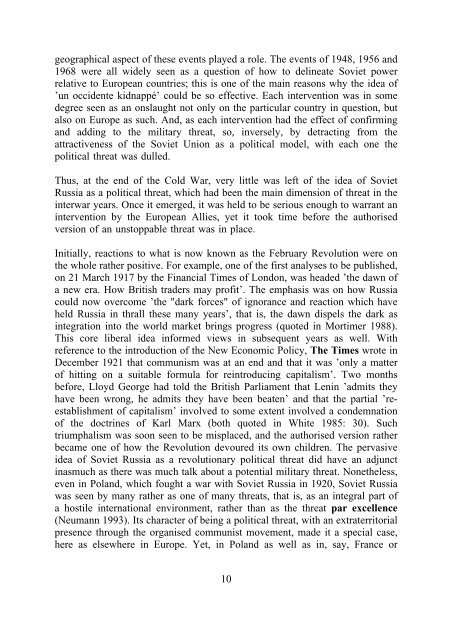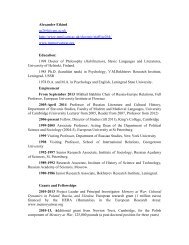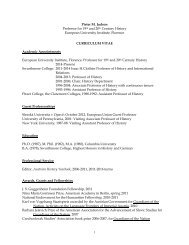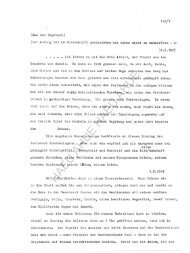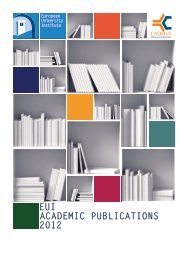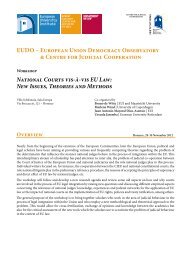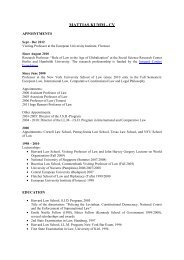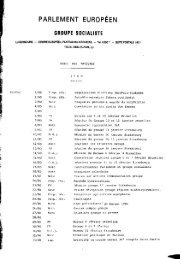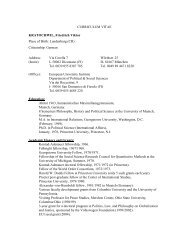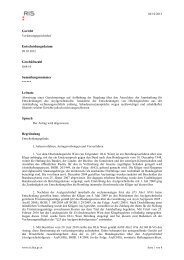RUSSIA AS EUROPE'S OTHER Iver B. Neumann European ...
RUSSIA AS EUROPE'S OTHER Iver B. Neumann European ...
RUSSIA AS EUROPE'S OTHER Iver B. Neumann European ...
Create successful ePaper yourself
Turn your PDF publications into a flip-book with our unique Google optimized e-Paper software.
geographical aspect of these events played a role. The events of 1948, 1956 and<br />
1968 were all widely seen as a question of how to delineate Soviet power<br />
relative to <strong>European</strong> countries; this is one of the main reasons why the idea of<br />
’un occidente kidnappé’ could be so effective. Each intervention was in some<br />
degree seen as an onslaught not only on the particular country in question, but<br />
also on Europe as such. And, as each intervention had the effect of confirming<br />
and adding to the military threat, so, inversely, by detracting from the<br />
attractiveness of the Soviet Union as a political model, with each one the<br />
political threat was dulled.<br />
Thus, at the end of the Cold War, very little was left of the idea of Soviet<br />
Russia as a political threat, which had been the main dimension of threat in the<br />
interwar years. Once it emerged, it was held to be serious enough to warrant an<br />
intervention by the <strong>European</strong> Allies, yet it took time before the authorised<br />
version of an unstoppable threat was in place.<br />
Initially, reactions to what is now known as the February Revolution were on<br />
the whole rather positive. For example, one of the first analyses to be published,<br />
on 21 March 1917 by the Financial Times of London, was headed ’the dawn of<br />
a new era. How British traders may profit’. The emphasis was on how Russia<br />
could now overcome ’the "dark forces" of ignorance and reaction which have<br />
held Russia in thrall these many years’, that is, the dawn dispels the dark as<br />
integration into the world market brings progress (quoted in Mortimer 1988).<br />
This core liberal idea informed views in subsequent years as well. With<br />
reference to the introduction of the New Economic Policy, The Times wrote in<br />
December 1921 that communism was at an end and that it was ’only a matter<br />
of hitting on a suitable formula for reintroducing capitalism’. Two months<br />
before, Lloyd George had told the British Parliament that Lenin ’admits they<br />
have been wrong, he admits they have been beaten’ and that the partial ’reestablishment<br />
of capitalism’ involved to some extent involved a condemnation<br />
of the doctrines of Karl Marx (both quoted in White 1985: 30). Such<br />
triumphalism was soon seen to be misplaced, and the authorised version rather<br />
became one of how the Revolution devoured its own children. The pervasive<br />
idea of Soviet Russia as a revolutionary political threat did have an adjunct<br />
inasmuch as there was much talk about a potential military threat. Nonetheless,<br />
even in Poland, which fought a war with Soviet Russia in 1920, Soviet Russia<br />
was seen by many rather as one of many threats, that is, as an integral part of<br />
a hostile international environment, rather than as the threat par excellence<br />
(<strong>Neumann</strong> 1993). Its character of being a political threat, with an extraterritorial<br />
presence through the organised communist movement, made it a special case,<br />
here as elsewhere in Europe. Yet, in Poland as well as in, say, France or<br />
10


